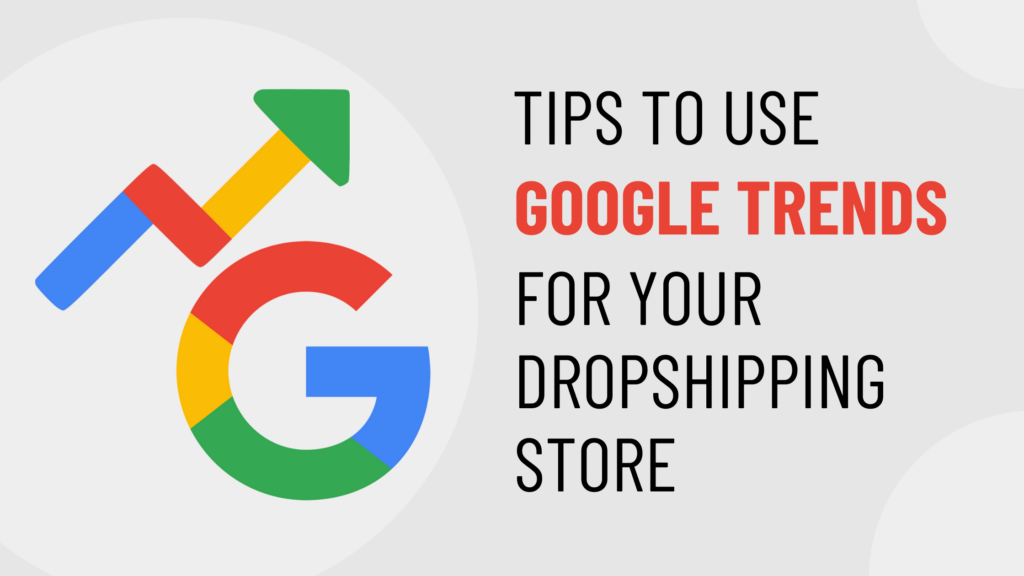8 Tips to Use Google Trends for Your Dropshipping Store
Market research is vital for the success of any dropshipping business. Understanding customer preferences and market trends helps in making informed decisions. Google Trends emerges as a valuable tool for dropshipping ventures, offering free access to real-time data on search trends. By analyzing dropshipping trends on Google, businesses can gain valuable insights into consumer behavior and market dynamics.
In this blog, we’ll explore eight key tips for leveraging Google Trends effectively to enhance decision-making in dropshipping. These tips will encompass strategies for using Google Trends for market research, analyzing dropshipping trends, and developing robust Google Trends strategies for ecommerce success. Let’s uncover how Google Trends can empower your dropshipping store to stay ahead of the competition and capitalize on emerging opportunities.
Understanding Google Trends and its Features
Google Trends offers several valuable features that can aid in leveraging Google Trends for dropshipping and analyzing dropshipping trends effectively.
Google Trends provides insights into various aspects of search behavior:
- Search volume trends: This feature displays the popularity of search terms over time, allowing dropshipping store owners to identify rising or declining trends in customer interest.
- Regional interest: By analyzing regional interest data, store owners can understand geographic variations in search trends, enabling targeted marketing efforts.
- Related queries and topics: Google Trends showcases related search queries and topics, helping store owners discover relevant keywords and niche markets to explore.
- Comparison of multiple search terms: This feature allows users to compare the search interest of multiple terms simultaneously, facilitating competitive analysis and trend identification.
Each feature of Google Trends can be utilized for market research and analyzing dropshipping trends:
- Search volume trends help in identifying popular products or niches.
- Regional interest data aids in targeting specific geographic markets.
- Related queries and topics provide insights into customer interests and preferences.
- Comparison of multiple search terms enables competitive analysis and trend forecasting.
Why Use Google Trends for Dropshipping?
Google Trends is a powerful tool for leveraging dropshipping trends on Google and conducting market research for your ecommerce business. By analyzing dropshipping trends on Google, you can gain valuable insights to drive your business forward:
- Identify dropshipping trends based on search volume to understand customer demand. By examining search trends, you can gauge which products or niches are gaining popularity and tailor your offerings accordingly.
- Discover emerging product niches with high growth potential. Google Trends allows you to spot rising trends and capitalize on new opportunities before they become saturated in the market.
- Make informed decisions about product selection and marketing strategies. By analyzing Google Trends data, you can determine which products are in high demand and adjust your inventory and marketing efforts accordingly.
- Gain insights into seasonal trends for effective inventory management and promotions. Google Trends provides valuable information about seasonal fluctuations in search interest, helping you plan inventory and promotions for maximum impact.
- Stay ahead of the competition by identifying rising trends before they peak. By monitoring Google Trends regularly, you can stay ahead of competitors and position your dropshipping store as a leader in your niche.
8 Tips to Leverage Google Trends for Your Dropshipping Store
Tip 1: Identifying Trending Products and Niches
Leveraging Google Trends for dropshipping involves using it to discover emerging product trends. By exploring search queries related to your niche, you can uncover rising trends and capitalize on them before they peak.
Analyzing search volume trends on Google Trends helps in identifying profitable niches for dropshipping stores. By observing the popularity of specific keywords over time, you can pinpoint niche markets with high demand and low competition, allowing you to target lucrative opportunities effectively.
For example, if you notice a spike in searches for “sustainable home decor,” consider adding eco-friendly home decor items to your dropshipping inventory. Use Google Trends for market research to stay ahead of trends and capitalize on emerging opportunities.
Tip 2: Seasonal Trends and Timing
Utilize Google Trends to grasp the ebbs and flows of search interest throughout the year. By analyzing dropshipping trends on Google, you can identify when certain products peak in popularity during specific seasons or holidays.
Strategize your dropshipping store promotions and product launches around these seasonal trends. For instance, if Google Trends indicates a surge in interest for beach accessories as summer approaches, plan your marketing campaigns and inventory accordingly.
Maximize sales by capitalizing on timely trends. Adjust your offerings to align with seasonal demands and ensure your dropshipping store remains relevant and appealing to customers throughout the year.
Tip 3: Analyzing Competitor Trends
Google Trends allows you to compare search interest for your products against competitors. By entering relevant search terms, you can see how interest in your products compares to similar offerings in the market.
This comparison helps in identifying gaps in the market where demand is high but competition is low. These gaps present opportunities for differentiation, allowing you to tailor your dropshipping store’s offerings to meet unmet customer needs.
To stay ahead of competitors, regularly monitor Google Trends data and adjust your strategies accordingly. This may involve capitalizing on emerging trends, optimizing marketing efforts, or introducing new products based on market demand. Leveraging Google Trends for market research empowers you to make informed decisions and maintain a competitive edge in the ecommerce landscape.
Tip 4: Geo-targeting and Localized Marketing
By leveraging Google Trends for dropshipping, analyze regional interest data to pinpoint specific geographic markets showing high demand for your products. Customize your marketing campaigns and product offerings according to regional preferences identified through Google Trends insights. Tailor your messaging, promotions, and product selection to resonate with the target audience in each location.
For example, if Google Trends indicates a surge in interest for a particular product category in a specific city or region, you can create localized ad campaigns targeting that area to capitalize on the trend and drive sales. Similarly, adjusting product descriptions or features to align with regional preferences can enhance engagement and conversions.
Tip 5: Content Marketing and SEO Optimization
Begin by leveraging Google Trends for dropshipping to identify popular search queries related to your products. Analyze dropshipping trends on Google to understand what topics and keywords are currently trending among your target audience.
Create content that aligns with these trending topics to attract organic traffic to your dropshipping store. By addressing the interests and needs of your potential customers, you can establish your store as a valuable resource in your niche.
Optimize your website content and product descriptions based on Google Trends data. Incorporate relevant keywords and phrases into your content to improve its visibility in search engine results. By aligning your content with popular search queries, you can increase the likelihood of attracting qualified leads to your dropshipping store.
Tip 6: Trend Forecasting and Long-term Planning
Google Trends offers valuable historical data that can be analyzed to forecast future trends and predict market demand. By examining past search patterns and identifying recurring trends, dropshipping store owners can anticipate upcoming shifts in consumer interests and preferences.
Implementing strategies for long-term planning involves adapting dropshipping store offerings based on insights gleaned from Google Trends data. This may include diversifying product selections, expanding into emerging niches, or adjusting marketing strategies to align with projected trends.
For example, if Google Trends indicates a rising interest in eco-friendly products, a dropshipping store owner could plan to introduce sustainable product lines or incorporate green marketing initiatives to capitalize on this trend and drive future growth. By proactively anticipating market shifts and planning accordingly, dropshipping businesses can position themselves for long-term success in the dynamic ecommerce landscape.
Tip 7: Monitoring and Tracking Trends
Consistently monitoring Google Trends is crucial for understanding shifts in search interest related to dropshipping trends on Google. Regularly checking the data allows you to track changes over time, identifying emerging trends and seasonal fluctuations. Utilize Google Trends alerts to receive notifications about relevant trends and developments in the dropshipping industry. These alerts keep you updated in real-time, ensuring you stay ahead of the curve and can adapt your strategies accordingly.
Adjust your dropshipping strategies based on real-time Google Trends data. If you notice a sudden spike in interest for a particular product or niche, consider capitalizing on the trend by adjusting your marketing campaigns or expanding your product offerings. Staying agile and responsive to Google Trends insights can help you maximize the effectiveness of your dropshipping store.
Tip 8: Integrating Google Trends with Other Tools and Data Sources
To enhance your dropshipping strategy, integrate Google Trends data with other market research tools and analytics platforms. This allows you to gain a more comprehensive understanding of market trends and customer behavior. By cross-referencing Google Trends data with sales data and customer feedback, you can maximize insights. This helps in identifying correlations between search trends and actual purchasing patterns, enabling more informed decision-making.
Implement strategies for building a robust dropshipping strategy through integrated data analysis. Combine Google Trends insights with data from other sources to develop targeted marketing campaigns, optimize product offerings, and stay ahead of emerging trends in the ecommerce landscape.
Conclusion
Leveraging Google Trends for dropshipping can significantly boost your chances of success in the competitive e-commerce landscape. By analyzing dropshipping trends on Google, you can identify lucrative niches, capitalize on seasonal opportunities, and stay ahead of the competition.
Google Trends is a powerful and free tool for market research, offering valuable insights into customer interests and behaviors. Whether you’re a beginner or seasoned entrepreneur, using Google Trends for market research is essential for making informed decisions and optimizing your dropshipping strategy. So, don’t hesitate to start exploring Google Trends and unlock its full potential for your dropshipping store’s success.
Google Trends for Dropshipping FAQs
Is Google Trends good for dropshipping?
Yes, Google Trends is excellent for dropshipping. It provides valuable insights into market trends, customer interests, and competition, helping dropshippers make informed decisions and optimize their strategies for success.
Does Google Trends cost money?
No, Google Trends is a free tool provided by Google. It offers valuable insights into search trends and data without requiring any payment or subscription fees.
How to find a product for dropshipping?
To find a product for dropshipping, research trending items using tools like Google Trends, analyze market demand and competition, consider niche audiences, and evaluate profit potential.
How to use google trends for market research?
To use Google Trends for market research, analyze search trends, identify emerging topics, compare keywords, and track regional interest. It’s a free tool offering valuable insights for informed decision-making.






